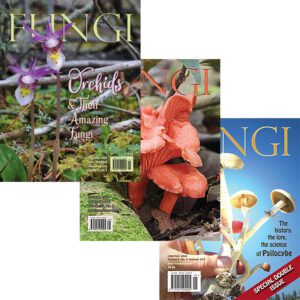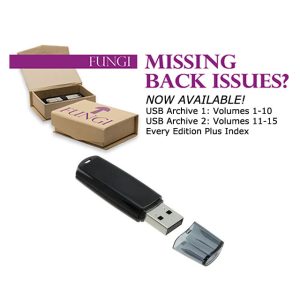It takes a special group of people to create each and every edition of FUNGI!
The fungi are the most audacious and interesting living organisms on the planet. It takes an equally audacious publication to bring the world of the fungi to you. Indeed, no other journal covers the world of fungi as does FUNGI. Or as successfully. FUNGI has the largest circulation of all North American mycological publications (academic, trade, or popular / general audience) and we continue to grow in popularity across the globe.
FUNGI is about all things mycological and just about anything goes. We’ve devoted entire editions on commercially important fungi like chaga and morels, scientifically challenging issues like ethnomycology, and topics that no one else dares cover like the genus Psilocybe. (Paul Stamets, world authority on the group, said that the FUNGI special issue on Psilocybe was the most significant publication on the topic in the past 20 years!) And we are the first to do an edition in 3D. Expect the unexpected in each and every audacious issue of FUNGI!
FUNGI’s beginnings: The Tipping Point
The very first issue of FUNGI was the culmination of nearly a year’s worth of work on the parts of several of the Editors and myself. Many of us had worked together previously on other publications, including NAMA’s newsletter and journal (McIlvainea); we shared ideas of what a North American mycological magazine should be and some of these ideas were based on the existing format of some of the many European journals. Early on, some of us had minor disagreements over the style and content of a new mycological magazine, but we were all in agreement from Day 1 about the pressing need for a journal that addresses the interests of amateur and professional mycologists. Of course launching a new periodical is a bit nerve-racking and I found myself asking, “If we build it, will they come?” Several recent events led us to the conclusion that something new and audacious had to happen. One such event was the termination of the British journal The Mycologist. But the tipping point came to me by way of commentary from Gary Lincoff, author of The Audubon Society Field Guide to North American Mushrooms. He told me that back in 1980, at the NAMA foray in North Carolina, Harry Knighton (basically, the founder of NAMA) dumped a load of European mushroom journals on the table during a Board of Trustees meeting one year. It was Gary’s first year as President of NAMA and Harry was so upset over the downward spiral of McIlvainea that he stormed up and down the room, yelling loud enough for folks outside to hear. I understand there was some betting on whether Gary would walk out or be carried out! Harry Knighton felt that, at the very least, North American mycologists should have a magazine of their own that was the equal of what the Europeans were publishing. I passionately share those same sentiments and am confident that this issue represents the first audacious step towards that goal.
On behalf of everyone at FUNGI, I give you my warmest regards,


Editorial Board
Publisher & Editor-In-Chief
- Britt A. Bunyard
Design & Production
- Jan Hammond
Contributing Illustrators
- Aaron Birk
- Mary Schaefer Brink
- Aaron “Inkling” Cruz Garcia
- Talia Hudgins
Contributing Editors
- Denis Benjamin
- Michael Beug
- Alan R. Biggs
- Susan Goldhor
- Art Goodtimes
- Edward Matisoff
- Lawrence Millman
- Robert Dale Rogers
- David Rose
- Mark Spear
- Krista Towns
- Steve Trudell
- Else C. Vellinga
- Michael Wood
Editorial Review
- Cathy Cripps, Montana State University
- Harold W. Keller, The Botanical Research Institute of Texas
- Patrick Leacock, The Field Museum of Natural History Chicago, Illinois
- Lawrence M. Leonard, M.D. Portland, Maine
- Michael Nicholson, Oxnard College, California
- David Pilz Pilz, Pilzwald – Forestry Applications of Mycology, Corvallis, Oregon
- Bruch Reed, Illinois Mycological Association & North American Mycological Association
- Paul Stamets, Fungi Perfecti
- Steve Trudell, University of Washington, Seattle
- Else C. Vellinga Berkeley, California
- Andrus Voitk, Foray Newfoundland & Labrador Corner Brook, Newfoundland
Publisher’s Notes
Although many wild mushrooms are quite palatable, some are deadly poisonous. It is advisable to avoid eating any wild organisms, including fungi, unless absolutely certain of identification. And, although some mushroom species are edible for many people, those same species may cause allergic reactions or illness in others. When in doubt, throw it out. It is a good idea to have any wild mushrooms checked by an expert before eating them. It should be understood that the Publisher and all Editors are not responsible for any consequences of ingesting wild mushrooms. Furthermore, the Publisher and all Editors are not engaged, herein, in the rendering of any medical advice or services. All readers should verify all information and data before administering any drug, therapy or treatment discussed herein. Neither the Editors nor the Publisher accepts any responsibility for the accuracy of the information or consequences from the use or misuse of the information contained herein. Unauthorized reproduction of published content of FUNGI is strictly forbidden and permission for reproduction must be obtained by application in writing to the Publisher.
Subscriptions
Sponsored By





